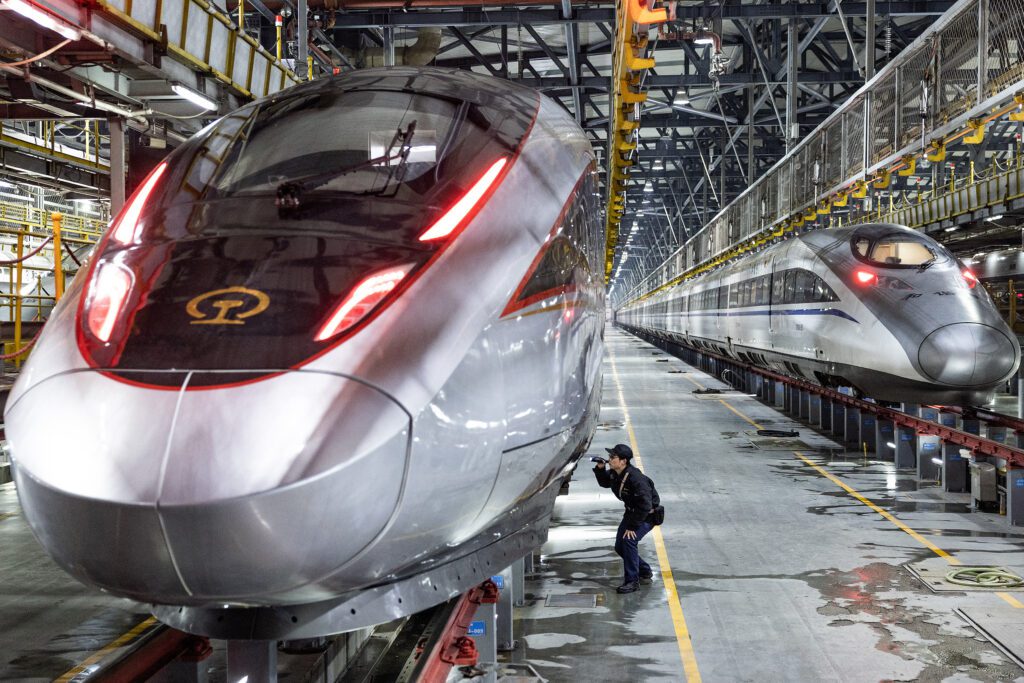Serbian President Aleksandar Vucic hailed a Chinese company working on a high-speed rail line connecting Belgrade to Budapest, in Hungary, as “a miracle” as a new high-speed train was unveiled in the Serbian capital on Friday.
The rail network is part of China’s Belt and Road Initiative in Europe, a major scheme announced by the Chinese government in 2013 which is intended to develop infrastructure across large parts of Asia, east Africa and Eastern Europe in what critics claim is a bid to dramatically increase Beijing’s influence.
China has been working hard to strengthen ties with Serbia and Hungary and the two countries were visited, along with France, by President Xi Jinping during his visit to Europe in May. Both Serbia and Hungary enjoy warm relations with Russia, China’s main ally, though the latter is also a member of NATO and the European Union.
According to Chinese state news agency Xinhua the train unveiled on Friday at the Zemun train station can travel at up to 200 kilometers (124 miles) per hour and has 250 seats.
Vucic announced at the event that Serbia had ordered five of the trains from the China Railway Rolling Stock Corporation, which are intended to be used along the Belgrade-Budapest railway which is currently under construction.
He commented: “The last one should arrive according to the contract on Dec. 31, 2025. We will carry out tests for the Belgrade-Subotica line already in September, and no later than Dec. 1. If we finish the line by then, and we will, you will ride this train Belgrade-Subotica.”
Referring to the engineering company which is working on the railway line Vucic added: “I especially want to thank the China Communications Construction Company (CCCC), which is probably the best company that has ever done something in Serbia. That company is a miracle and it’s amazing how these people work.”
Chinese constructors have already completed a rail line between Belgrade and Novi Sad, Serbia’s second biggest city, and the plan is to extend this to Subotica near the Hungarian border by December. Once completed the Belgrade-Budapest railway, which a number of Chinese companies are involved in constructing, is planned to be 217 miles long.
High speed trains pictured at a maintenance base in Wuhan, in China’s central Hubei province early on January 26, 2024. Chinese companies are helping build a railway between Budapest and Belgrade as part of the…
High speed trains pictured at a maintenance base in Wuhan, in China’s central Hubei province early on January 26, 2024. Chinese companies are helping build a railway between Budapest and Belgrade as part of the country’s Belt and Road Initiative.
More
STR/AFP/GETTY
Vucic on Friday also expressed a hope that Serbia would end up building its own trains, commenting: “We import the best quality and most beautiful trains. I hope that we will build them soon. That would be very important for the growth of Serbia.”
According to Statista, in 2021 the Chinese high-speed rail network stretched to 25,000 miles and in 2019, 2.3 billion individual journeys were made on its lines, equating roughly 63 percent of all passenger rail travel in China.
The past few years have seen a renaissance in plans for high-speed railways, with construction beginning in January on a 218-mile line intended to link Las Vegas, Nevada, to southern California. In April, President Joe Biden endorsed a proposed 240-mile-per-hour line linking Houston and Dallas in Texas. There are also proposals for a line connecting Dallas to Fort Worth.
Uncommon Knowledge
Newsweek is committed to challenging conventional wisdom and finding connections in the search for common ground.
Newsweek is committed to challenging conventional wisdom and finding connections in the search for common ground.
Source link : https://www.newsweek.com/chinese-high-speed-rail-project-europe-hailed-miracle-1910036
Author :
Publish date : 2024-06-08 11:00:59
Copyright for syndicated content belongs to the linked Source.
